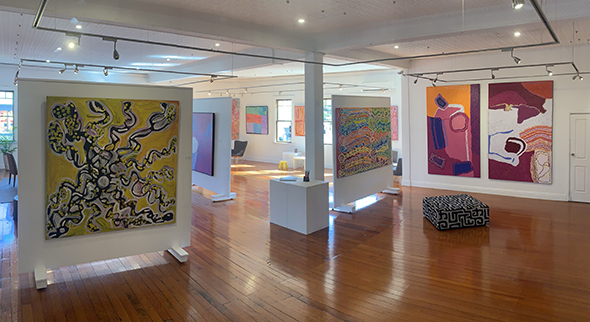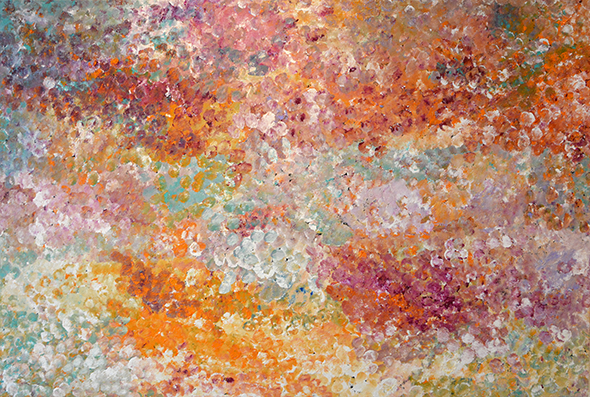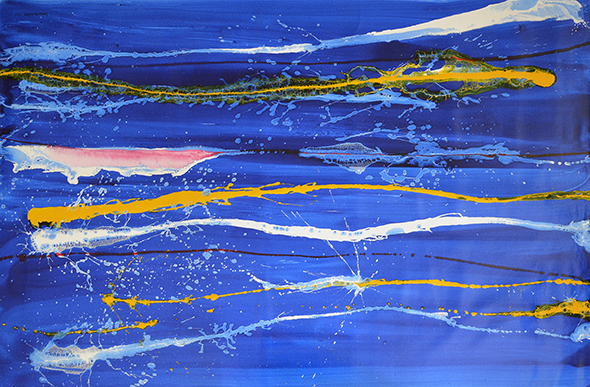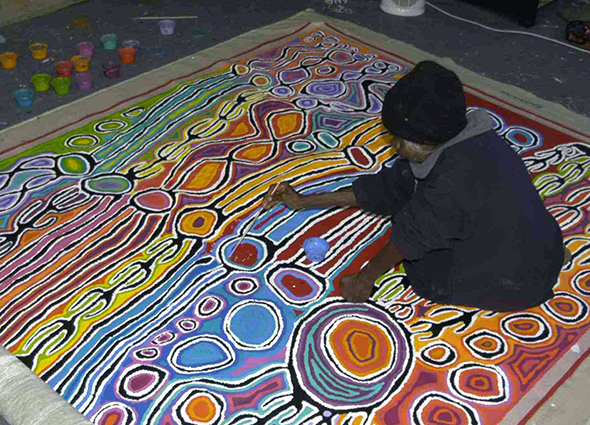Welcome to our second exhibition in the ‘defining tradition’ exhibition series. In this show, we’re celebrating the trailblazing artists who pursued an adventurous use of colour.
article | related videos | exhibition catalogue | online exhibition

Our inaugural ‘defining tradition’ exhibition in January, titled ‘the first wave & its disciples’, focused on the genesis of the western desert art movement at Papunya in 1971, when senior men essentially invented a new art form. We presented artists that have remained the faithful disciples of the muted colour palettes and powerful expression of Tjukurrpa (Dreaming) as first set down by those pioneers of western desert art.
For many visitors to the gallery, the natural ochre pigments on display are what they had considered ‘traditional’ or the quintessential colours of Aboriginal art. Our second exhibition, ‘the colourists’, unveils that in experimenting with acrylics in Papunya in the 1970s, another great tradition was ignited - the use of bright colour.
As we completed hanging ‘the colourists’ exhibition, we couldn’t help but feel that the space was brighter, lighter and felt more uplifting. Our eyes were dancing around the space as we followed the sensuous pinks and reds found in Tommy Watson’s artworks, travelled across the dynamic lines of colour in Judy Watson Napangardi’s work, and felt the raw power in Lorna Fencer’s ‘Warna (Snake)’.
Before we delve deeper and discuss some of the fantastic artworks on display, we need to take a moment and debunk the notion that there’s none of this vibrant colour occurring naturally in the Australian landscape; that these artworks are somehow not an accurate or ‘authentic’ depiction of the Australian landscape. As I leave the urban jungle of Sydney - with its hazy air and restricted colour palette - and head to the ‘red centre’ of Alice Springs, the difference in colour is immense. The clean air, the bright Australian light and sensational contrasting colours sends my colour perception off the scale and everything is more intense. The mineral rich earth and stone also reflects a multitude of colours - making sunrise and sunset an incredibly magical time of the day. Everything does just seem more rich and vibrant in this special part of the world, with many landscape photographers commenting they have rarely seen the intensity of natural colour as found in our own backyard.
And then there is that magical time of the year, when for a few weeks the desert is blanketed with wildflowers. As far as the eye can see, there are vibrant splashes of blue, purple, yellow, along with more subtle pastel hues. It can be argued that many of the artists represented in this show are simply painting with colours they have experienced on Country. For me, this is perfectly typified by Polly Ngale’s gorgeous piece titled ‘Bush Plum’. Polly Ngale belongs to the oldest living generation of Utopia women and is considered one of the most accomplished painters to have worked there during the past twenty years. Polly’s artistic career began in the late 1970s when she, like many of the women in Utopia, began working with silk batik before venturing into works on canvas[1].

Most of Polly Ngale's paintings are centred around the 'Bush Plum'(or Conkerberry tree) and range from extremely fine dotting techniques with either interspersed colours or areas of varying colours and depth all blending together across the canvas. Through extensive over-dotting, she builds up layers of colour, blending or separate, to give a wealth of different and very attractive paint effects.
The Bush Plum - which is central to many of the works of artists’ of the Utopia community - provides an important food source for the Anmatyerre people and is frequently featured in the Women's dreaming stories. The fruits are harvested by shaking the trees until they fall to the ground but the fruits, although already quite sweet, need to be soaked in water to soften and plump them up for eating. The Bush Plum tree flowers in Spring and many of Polly's paintings have a distinctly Springtime air to them - one can readily sense a host of blossoms in her works.
Alternatively, some artists have used an adventurous colour palette to capture the energy or emotion of a site or Tjukurrpa (Dreaming). Lockhart River artist Samantha Hobson has an incredible ability to capture the colour and intensity of a moment and transform its radiant energy into an emotional charge pulsating through the artwork. Her Great Barrier Reef Series captures the jewel like quality of this pristine natural wonder, with bold splashes of paint conjuring those twinkling seconds a wave breaks. Her Series leaves the viewer feeling energised, much like a dip in the fresh saltwater. Art historian Sally Butler perfectly explains Samantha Hobson’s work as “close to abstract expressionism, but there is always something that keeps it in touch with visible reality. This is because her art is about seeing the world, not a way of imagining it”.

Another fantastic example of colour being used to express an emotion is Betty Mbitjana’s ‘Awelye’ - in this artwork Betty depicts the designs that the women would paint on their bodies, and the dancing tracks which are made in the sand during the women's awelye ceremony. Betty has chosen an array of bright, bold colours. For me, this is the happiest artwork of the entire exhibition. If feels as if Betty is expressing the joy and celebration that occurs during the awelye ceremony. Betty’s artworks have a fantastic sense of greeting, and have a very uplifting effect in any area where they hang.
Another interesting item to consider when viewing ‘the colourists’ exhibition is how the artist has applied colour to the canvas. It is well known that the late Kudditji Kngwarreye would sing while he painted, as if to infuse the paint with his songlines and stories of Country. In the case of Judy Watson Napangardi, her brush was loaded with original and vital colour which she shuffled across the canvas, never losing connection between the brush and canvas. Interestingly, it is said that the ancestral women danced across country, and Warlpiri women of today channel their ancestors when they dance in ceremony, shuffling through the sand, never losing connection to Country. The method in which the paint has been applied could also imply a deep, ancient tradition.

Judy Watson Napangardi was one of the trailblazing artists at Yuendumu, who cemented Warlukurlangu Art Centre’s reputation for their bold use of colour through an unrestricted palette[2]. Another early distinctive feature was the use of very traditional iconography. As explained by Warlukurlangu Art Centre, “the artists painted Jukurrpa (dreaming story), ensuring appropriate Warlpiri relationships of kirda (owners) and kurdugurlu (guardians) were followed and the images reflected the social and cultural obligations present in ceremonies and day-to-day life in the community. The kurawarri, the iconographic elements of a painting that held the story, were painted first and scrutinized by others for their adherence to Jukurrpa. The dotting that filled the canvases was less important, and many artists developed varying styles of application and experimented with different colours while maintaining a consistency in their presentation of kuruwarri”.
Nowadays, the paintings tell the story of the artists’ connection to their country, the features of the landscape, the plants and animals that are found there and the creation story that occurred in the Dreamtime. These stories are still very relevant to the artists today. Artists have their own particular styles or palettes, and constantly experiment and vary their paintings, so the works are constantly evolving.
As I walk through ‘the colourists’ exhibition, I also love how the art captures a sense of the artists personality - none more so than the incomparable Lorna Fencer Napurrula. We have created our own Lorna Fencer Photo Page to give you some insight into the persona of the artist and I think help to put her bold and uncompromising artwork into context.
Whilst many of the trailblazing artists featured in the show are no longer with us, it is heartening to see the next generation taking up the brush. In this exhibition alone we have artworks by the great Minnie Pwerle, her daughters Betty Mbitjana and Barbara Weir, and granddaughter Charmaine Pwerle (Barbara Weir’s daughter).
Coming away from ‘defining tradition | the colourist’ exhibition, I realise that no artist can work in a vacuum. We are all influenced by what we see around us. Painters are influenced by what other painters did before them. The colours we see and use, the effects in nature we try to convey, the things which inspire us and make us want to paint; all these reactions are conditioned by the traditions we respect and the influences and conventions we absorb - many of them unconsciously.
I encourage you all to see this monumental display of artworks and get some colour into your life!
Related Videos
[1] Preceding the expansion of the Papunya Tula movement to communities such as Yuendumu and Balgo Hills in the mid 1980s, Pitjantjatjara women in Ernabella and Anmnatyerr/Alyawarr women at Utopia station celebrated colour in their fluid batiks, before making the transition to canvas in the late 1980’s, when the art world really began to take notice.
[2] In the early 1970s Paddy Japaljarri Stewart was involved in the painting of the mural on the Papunya School wall. In 1983 he and Paddy Japaljarri Sims were instrumental together with other senior men in the painting of the now famous Yuendumu school doors. They went on with other senior leaders including Darby Jampinjnpa Ross, Jack Jakamarra Ross, Samson Japaljarri Martin and senior women including Uni Nampijinpa Martin, Dolly Nampijinpa Daniels, Rosie Nangala Fleming and Maggie Napangardi Watson to found the Warlukurlangu art centre in 1985. It was incorporated in 1986.